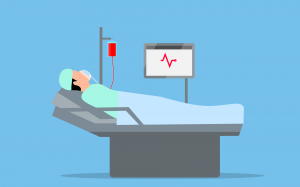In the upcoming series of articles, two kidney-disease patients John and Jane (aliases) will share their personal patient journey with us. Part I focuses on how to get diagnosed with kidney disease.
We are very thankful to John and Jane for sharing their personal experiences and shed light on the broad spectrum of kidney disease. Furthermore, thanks to the contributing experts from our partners for their input for this article: Dr. Marcel Naik (Charité), Dr. Mozhgan Bayat (HPI), Aadil Rasheed (HPI), Dr. Matthieu Schapranow (HPI). Images by Elf-Moondance, Mohamed Hassan.
Getting diagnosed with kidney disease
The diagnosis of kidney disease comes suddenly for the majority of patients, because symptoms are usually unspecific when kidney function starts to degrade. Therapy options vary depending on the kind of kidney disease and its progression. Nephrologists, specialists in internal medicine focusing on kidney diseases, are the medical doctors, who decide on the individual therapy. The appropriate diagnosis and treatment of existing comorbidities and risk factors with impact on the renal system, such as high blood pressure or diabetes mellitus, require special attention. Therapy options range from medication to special diets. Furthermore, the patient’s knowledge about her/his illness is also decisive for his further fate. The stage of kidney disease can occur suddenly (acute) or over a long timespan (chronic).
Chronic kidney disease
The majority of kidney failures is due to a gradual decline in renal function, also known as Chronic Kidney Disease (CKD). Risk factors for CKD are, amongst others, diabetes, hypertension or genetic predisposition.
John: “I have had kidney disease since I was born. When I was one year old, it was discovered that my kidneys were malformed. My mother always told me that my left kidney was the size of a pea and had an open ureter. It was removed when I was nine months old. There was a kink in the ureter of my right kidney, causing a constant back pressure on the kidney. In the middle of the 1970s, a surgery of the ureter was not possible because the risk was too high that the kidneys would not work. At that time, my parents were already informed that most likely at the age of ten, my kidneys would stop working and that I would have to go on dialysis. The diagnoses were made in 1976/1977 at the Charité. Since then, I’ve always been to the Charité to check my kidneys.”
Acute kidney injury
In contrast to CKD, Acute Kidney Injury (AKI) comes with a rapid decrease of kidney function. It is caused by fluid loss in 80% of the cases, e.g. due to bleeding or diarrhea. In 15% of the cases, urine congestion leads to outflow obstruction resulting in kidney malfunction. If urine congestion is restored or fluid loss is compensated, kidney malfunction resolves usually. However, approx. 5-10% of AKI patients do not recover and patients need permanent renal replacement therapy, i.e. from dialysis to kidney transplantation.
Jane: “The diagnosis of kidney failure happened very suddenly for me, as I was still recovering from the birth of my son in an intensive care unit. Because of a severe hemorrhage I was hospitalized for a couple of days, I was not aware of what was happening to me. When I started to become more responsive, doctors told me about the hemorrhage and the partially successful interventions after that. There were still several problems keeping me in hospital. One of those problems was acute kidney failure.
At that moment, I’m not sure if I cared. It seemed all a bit too much to handle. My husband visited the ward with our newborn every day. A newborn for whom I had to care for and feed. The nurses made a fuss about a newborn visiting the intensive care ward. Probably due to safety reasons, I’m sure. But this constant discussion of my newborn child being able to visit me or not, my stressed-out husband and my crying son took all the little energy I already had. A doctor was telling me probably all would be fine. All I wanted to hear, everything will be temporary, not something I needed to think about.”
How to assess the kidney function?
The main task of our both kidneys is to retrieve valuable nutrients from the primary urine whilst cleaning the blood. The toxins cleaning quality is measured through the calculated estimated Glomerular Filtration Rate (eGFR). It is calculated by including patient-specific parameters, e.g. gender, age, ethnic origin, and the blood creatinine. An eGFR level >90ml/min is considered as an indicator for a healthy kidney function. Thus, a healthy kidney filters more than 90ml/min or approx. 130l daily, but only approx. 2l/d of urine are excreted. As a result, the main task of the kidneys is to retain valuable nutrients and fluids within the body whilst extracting toxins.
Stages of kidney disease
Chronic kidney disease
| Stage | Description | eGFR (ml/min/1.73 m2) |
| 1 | Kidney damage with normal eGFR | 90 |
| 2 | Kidney damage with mild eGFR | 60-89 |
| 3A | Mild to moderate eGFR | 45-59 |
| 3B | Moderate eGFR | 30-45 |
| 4 | Sever eGFR | 15-30 |
| 5 | Kidney failure | < 15 or dialysis |
Tab. 1: Stages of chronic kidney disease (CKD) based on estimated glomerular filtration rate (eGFR). Adapted from Renal Association
The five stages of CKD are defined based on eGFR as depicted in Tab. 1.
- In stage I, the kidneys are still working well. Patient might not have any symptoms, but there might be protein in urine already detected.
- In stage II, eGFR is reduced to values between 60 to 90ml/min, but kidneys are working at normal levels. There might be protein in the urine or physical damage to the kidney or hypertension.
- Stage III is reached if eGFR further drops. Kidneys do not work properly to filter extra fluid. The toxic and extra fluid can accumulate in the patient’s body and cause further damage. In this stage prevention of progression is the main focus. With medication and lifestyle changes risk factors for kidney damage such as hypertension, diabetes and smoking are addressed. Patients need to be well-educated about her/his kidney disease, because they have to avoid certain pain relievers and medication that otherwise would result in further kidney damage. Co-supervision by a nephrologist is highly recommended for kidney function impairment stage III and higher.
- Stage IV is the last stage before kidney failure. From stage IV, patients should intensively learn and discuss dialysis procedures so that dialysis can be started if the deterioration continues into stage V.
- In stage V, the kidneys no longer filter out waste from blood. At this stage, kidney transplantation is the best therapy option. However, it cannot be conducted immediately because there is a lack of donation organs. An alternative therapy option is dialysis: Either peritoneal dialysis (dialysis through peritoneal cavity) or hemodialysis (blood is cleaned with a machine).
Acute kidney injury
| Stage | Serum Creatine | Urine output |
| 1 | 1.5-1.9 times baseline within 1 week or ≥ 0.3 mg/dl increase within 48 hrs | < 0.5 ml/kg/h for 6-12 hrs |
| 2 | 2.0-2.9 times baseline | <0.5ml/kg/h for ≥ 12 hrs |
| 3 | 0.3 times baseline
or Increase in serum creatine to ≥ 4.0 mg/dl or initiation of RRT or In patients < 18 yrs decrease in eGFR to < 35 ml/min per 1.73 m2 |
<0.3 ml/kg/h for
≥ 24 hrs or Anuria for ≥12 hrs |
Tab. 2: Staging of AKI (KDIGO)
For AKI, kidney failure happens very suddenly. Tab. 2 summarizes the grading of AKI, which builds on serum creatine and urine output as important factors.
Systemic impacts of kidney diseases
The loss of function of the kidney leads to an accumulation of toxins within the body. As a result, several number of disorders can happen:
- Performance of the immune system degrades,
- Susceptibility to infections increases,
- Bleeding tendency increases, e.g. gastrointestinal bleedings.
Since healthy kidneys regulate blood pressure, the amount of water in the body, the content of red blood cells and various electrolytes via hormones. The progression of the kidney disease can also lead to:
- High blood pressure (arterial hypertension),
- Water retention (edema),
- Bone mineral disorders,
- Anemia, and
- Electrolyte disorders.
The NephroCAGE consortium
The German Canadian consortium NephroCAGE combines medical and scientific-technical expertise from Germany and Canada. We are jointly creating Clinical Prediction Models (CPMs) based on latest Artificial Intelligence (AI) methods to evaluate their applicability for kidney transplantation patients in Germany and Canada. One of the clinical outcomes we are focusing on is the allograft survival after successful kidney transplantation, which incorporates the eGFR as predictive parameter.






Comments are closed